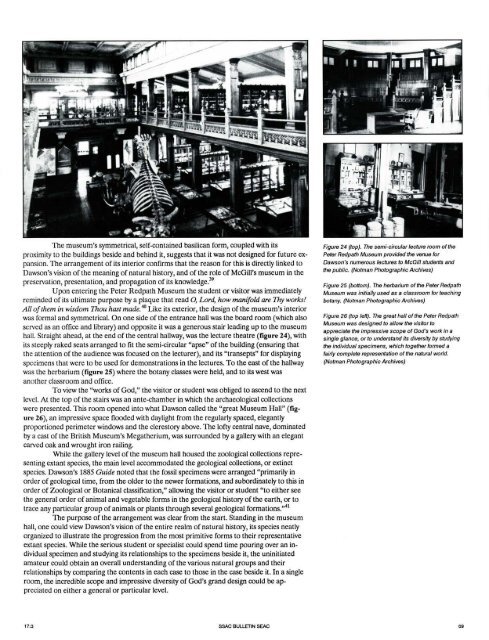society for the study of architecture in canada - SEXTONdigital ...
society for the study of architecture in canada - SEXTONdigital ...
society for the study of architecture in canada - SEXTONdigital ...
You also want an ePaper? Increase the reach of your titles
YUMPU automatically turns print PDFs into web optimized ePapers that Google loves.
The museum's symmetrical, self-conta<strong>in</strong>ed basilican <strong>for</strong>m, coupled with its<br />
proximity to <strong>the</strong> build<strong>in</strong>gs beside and beh<strong>in</strong>d it, suggests that it was not designed <strong>for</strong> future expansion.<br />
The arrangement <strong>of</strong> its <strong>in</strong>terior confirms that <strong>the</strong> reason <strong>for</strong> this is directly l<strong>in</strong>ked to<br />
Dawson's vision <strong>of</strong> <strong>the</strong> mean<strong>in</strong>g <strong>of</strong> natural history, and <strong>of</strong> <strong>the</strong> role <strong>of</strong> McGill's museum <strong>in</strong> <strong>the</strong><br />
preservation, presentation, and propagation <strong>of</strong> its knowledge. 39<br />
Upon enter<strong>in</strong>g <strong>the</strong> Peter Redpath Museum <strong>the</strong> student or visitor was immediately<br />
rem<strong>in</strong>ded <strong>of</strong> its ultimate purpose by a plaque that read 0, Lord, how manifold are Thy works!<br />
All <strong>of</strong> <strong>the</strong>m <strong>in</strong> wisdom Thou hast made. 40 Like its exterior, <strong>the</strong> design <strong>of</strong> <strong>the</strong> museum's <strong>in</strong>terior<br />
was <strong>for</strong>mal and symmetrical. On one side <strong>of</strong> <strong>the</strong> entrance hall was <strong>the</strong> board room (which also<br />
served as an <strong>of</strong>fice and library) and opposite it was a generous stair lead<strong>in</strong>g up to <strong>the</strong> museum<br />
hall. Straight ahead, at <strong>the</strong> end <strong>of</strong> <strong>the</strong> central hallway, was <strong>the</strong> lecture <strong>the</strong>atre (figure 24), with<br />
its steeply raked seats arranged to fit <strong>the</strong> semi-circular "apse" <strong>of</strong> <strong>the</strong> build<strong>in</strong>g (ensur<strong>in</strong>g that<br />
<strong>the</strong> attention <strong>of</strong> <strong>the</strong> audience was focused on <strong>the</strong> lecturer), and its "transepts" <strong>for</strong> display<strong>in</strong>g<br />
specimens that were to be used <strong>for</strong> demonstrations <strong>in</strong> <strong>the</strong> lectures. To <strong>the</strong> east <strong>of</strong> <strong>the</strong> hallway<br />
was <strong>the</strong> herbarium (figure 25) where <strong>the</strong> botany classes were held, and to its west was<br />
ano<strong>the</strong>r classroom and <strong>of</strong>fice.<br />
To view <strong>the</strong> "works <strong>of</strong> God," <strong>the</strong> visitor or student was obliged to ascend to <strong>the</strong> next<br />
level. At <strong>the</strong> top <strong>of</strong> <strong>the</strong> stairs was an ante-chamber <strong>in</strong> which <strong>the</strong> archaeological collections<br />
were presented. This room opened <strong>in</strong>to what Dawson called <strong>the</strong> "great Museum Hall" (figure<br />
26), an impressive space flooded with daylight from <strong>the</strong> regularly spaced, elegantly<br />
proportioned perimeter w<strong>in</strong>dows and <strong>the</strong> clerestory above. The l<strong>of</strong>ty central nave, dom<strong>in</strong>ated<br />
by a cast <strong>of</strong> <strong>the</strong> British Museum's Mega<strong>the</strong>rium, was surrounded by a gallery with an elegant<br />
carved oak and wrought iron rail<strong>in</strong>g.<br />
While <strong>the</strong> gallery level <strong>of</strong> <strong>the</strong> museum hall housed <strong>the</strong> zoological collections represent<strong>in</strong>g<br />
extant species, <strong>the</strong> ma<strong>in</strong> level accommodated <strong>the</strong> geological collections, or ext<strong>in</strong>ct<br />
species. Dawson's 1885 Guide noted that <strong>the</strong> fossil specimens were arranged "primarily <strong>in</strong><br />
order <strong>of</strong> geological time, from <strong>the</strong> older to <strong>the</strong> newer <strong>for</strong>mations, and subord<strong>in</strong>ately to this <strong>in</strong><br />
order <strong>of</strong> Zoological or Botanical classification," allow<strong>in</strong>g <strong>the</strong> visitor or student "to ei<strong>the</strong>r see<br />
<strong>the</strong> general order <strong>of</strong> animal and vegetable <strong>for</strong>ms <strong>in</strong> <strong>the</strong> geological history <strong>of</strong> <strong>the</strong> earth, or to<br />
trace any particular group <strong>of</strong> animals or plants through several geological <strong>for</strong>mations." 41<br />
The purpose <strong>of</strong> <strong>the</strong> arrangement was clear from <strong>the</strong> start. Stand<strong>in</strong>g <strong>in</strong> <strong>the</strong> museum<br />
hall, one could view Dawson's vision <strong>of</strong> <strong>the</strong> entire realm <strong>of</strong> natural history, its species neatly<br />
organized to illustrate <strong>the</strong> progression from <strong>the</strong> most primitive <strong>for</strong>ms to <strong>the</strong>ir representative<br />
extant species. While <strong>the</strong> serious student or specialist could spend time pour<strong>in</strong>g over an <strong>in</strong>dividual<br />
specimen and <strong>study</strong><strong>in</strong>g its relationships to <strong>the</strong> specimens beside it, <strong>the</strong> un<strong>in</strong>itiated<br />
amateur could obta<strong>in</strong> an overall understand<strong>in</strong>g <strong>of</strong> <strong>the</strong> various natural groups and <strong>the</strong>ir<br />
relationships by compar<strong>in</strong>g <strong>the</strong> contents <strong>in</strong> each case to those <strong>in</strong> <strong>the</strong> case beside it. In a s<strong>in</strong>gle<br />
room, <strong>the</strong> <strong>in</strong>credible scope and impressive diversity <strong>of</strong> God's grand design could be appreciated<br />
on ei<strong>the</strong>r a general or particular level.<br />
Figure 24 (top). The semi-circular lecture room <strong>of</strong> <strong>the</strong><br />
Peter Redpath Museum provided <strong>the</strong> venue <strong>for</strong><br />
Dawson's numerous lectures to McGill students and<br />
<strong>the</strong> public. (Notman Photographic Archives)<br />
Figure 25 (bottom). The herbarium <strong>of</strong> <strong>the</strong> Peter Redpath<br />
Museum was <strong>in</strong>itially used as a classroom <strong>for</strong> teach<strong>in</strong>g<br />
botany. (Notman Photographic Archives)<br />
Figure 26 (top left). The great hall <strong>of</strong> <strong>the</strong> Peter Redpath<br />
Museum was designed to allow <strong>the</strong> visitor to<br />
appreciate <strong>the</strong> impressive scope <strong>of</strong> God's work <strong>in</strong> a<br />
s<strong>in</strong>gle glance, or to understand its diversity by <strong>study</strong><strong>in</strong>g<br />
<strong>the</strong> <strong>in</strong>dividual specimens, which toge<strong>the</strong>r <strong>for</strong>med a<br />
fairly complete representation <strong>of</strong> <strong>the</strong> natural world.<br />
(Notman Photographic Archives)<br />
17:3 SSAC BUlLETIN SEAC<br />
69
















